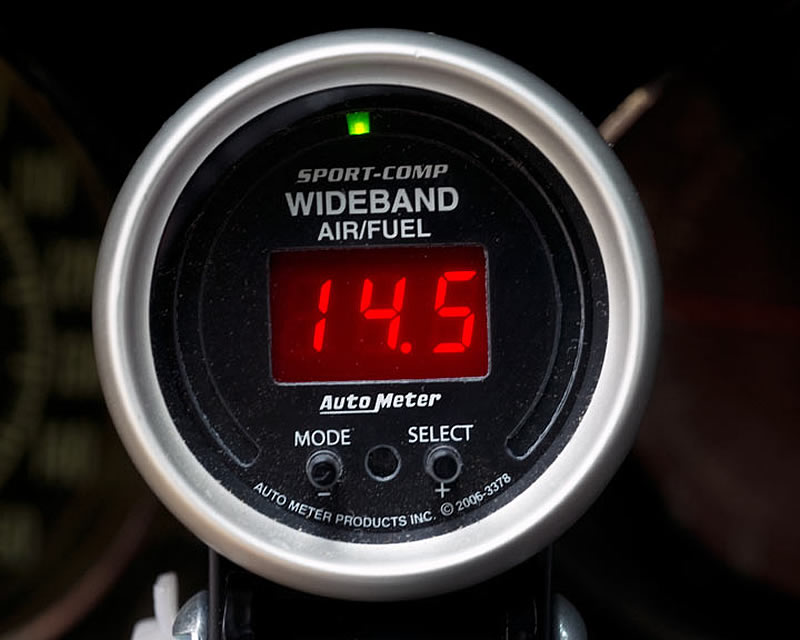My 1971 Corvette coupe is the only car I have left without electronic engine controls. It’s fed by a big, dumb, four-barrel carburetor, to be exact–a Holley 850 modified with a secondary intermediate circuit and a host of other performance and driveability tweaks done for the next installment of the Corvette Action Center’s “Big Block from Hell” series. In preparation for the carb retuning covered in that story, I replaced the narrow band O2 sensor and digital display I’d put on the car back in the early-’90s, with the new “Sport Comp Wideband Air/Fuel Pro” made by Auto Meter (PN 3378).
This wideband O2 is designed for use with gasoline but is adjustable for alternative fuels such as E85, ethanol, methanol, propane and compressed natural gas (CNG). It has data recording ability and has a output for on-board data acquisition systems. It is available in a host of styles that go with Auto Meter’s many lines of gauges.
 The gauge installation was easy as the car already had a sensor. I pulled out the old O2S and harness and put the new AutoMeter/Bosch LSU4.2 wideband sensor, which has a resolution of 0.1 air fuel ratio, in its place. I ran the wires the same way as before: from the O2S in the exhaust, though a grommeted hole in the driveline tunnel, under the console trim and then to the gauge on the steering column. I ran the AutoMeter’s power and ground wires to the same hot-with-ign-on location and ground I used before.
The gauge installation was easy as the car already had a sensor. I pulled out the old O2S and harness and put the new AutoMeter/Bosch LSU4.2 wideband sensor, which has a resolution of 0.1 air fuel ratio, in its place. I ran the wires the same way as before: from the O2S in the exhaust, though a grommeted hole in the driveline tunnel, under the console trim and then to the gauge on the steering column. I ran the AutoMeter’s power and ground wires to the same hot-with-ign-on location and ground I used before.
With this product, Auto Meter demonstrates why its instrumentation is the choice of racers and discriminating hot rodders. The two methods of displaying data are quite intuitive. In the center of the gauge face, there is a straight digital display on which you have the choice of seeing air-fuel ratio or lambda. There is a circular, digitally-generated analog-style display at the perimeter of the gauge with yellow LEDs for rich, green for near stoichiometric and red for lean. The gauge is the standard 2 1/16-in diameter and is intended for in-dash or A-pillar pod mounting but, also, can be mounted in a gauge “cup.” I chose to put the AFR gauge in an AutoMeter, carbon fiber cup (PN 2121) which I mounted on the steering column.
The installation of this wide-band air-fuel-ratio meter paid off almost immediately. On the first test drive with the AutoMeter, I noticed right away my wide open throttle AFR was somewhat rich, so I leaned that back until I saw between 12.5 and 13:1. I, also, noted by 6500 rpm the AFR was rich. My air filter was a restriction above 6250 rpm. Fixing that wasn’t easy, considering the limited hood clearance I have.
Another task the Auto Meter wideband made easier was secondary accelerator pump tuning. Before I started messing with it, I had a huge, 42 shooter. Road testing the car on a long hill by rapidly opening the throttle at 2000 rpm in second gear showed the initial secondary pump shot was just a tiny bit rich, but once the engine responded (ie: primaries and secondaries were wide open and the need for accelerator pump shot was past, the AFR want way rich, like 10.8-10.9:1 . That richness was temporary, gradually ending with the AFR hovering about 12.6 up to about 6250 rpm. I went to a smaller shooter and the engine developed a sag at secondary opening but was still way rich once the engine reached WOT followed by the same, gradual lean-out to 12.5.
That confirmed my early belief that the problem was the secondary pump shot being too long. The engine did not need the large, 50cc pump on the secondary side. I replaced the 50-cc pump with a 30-cc pump then installed a second, blue pump cam and a 37 secondary shooter. Wow! That really woke the car up in the low-mid-range. The car’s response was much more crisp and the AutoMeter Wideband backed-up that feeling showing me that AFR during the operation of both pumps was closer to 12.5:1.
The complete story on how I retuned my Holley 850 for better response and improved fuel economy will be posted here on the Corvette Action Center in the near future.
So…how is it there was a fair amount of fine tuning I had to do with a carb that was supposedly already sorted?
Simple. The narrow band sensor I was using before wasn’t as accurate. A narrow-band O2S is just that–narrow band–because it’s resolution either side of stoichiometric is poor, that is, you can tell the AFR is rich, but you can’t tell if it’s 12.0 or 12.5. That makes it tough to tune sometimes.
Having this AutoMeter wide-band O2 has vastly improved the quality of data I’ve been using to make my carburetor tuning decisions. It makes on-road tuning much easier. In fact, it would improve anyone’s tuning work regardless of what fuel mixing device their engine has, carburetor or electronic fuel injection. Bottom line…AutoMeter’s Wideband Air/Fuel Pro is pretty darn cool. It presents data in an easy-to-read manner. It’s accurate. It’s easy to install.
Want more information? Visit the AutoMeter web site at www.autometer.com and search using keyword “wideband”.

